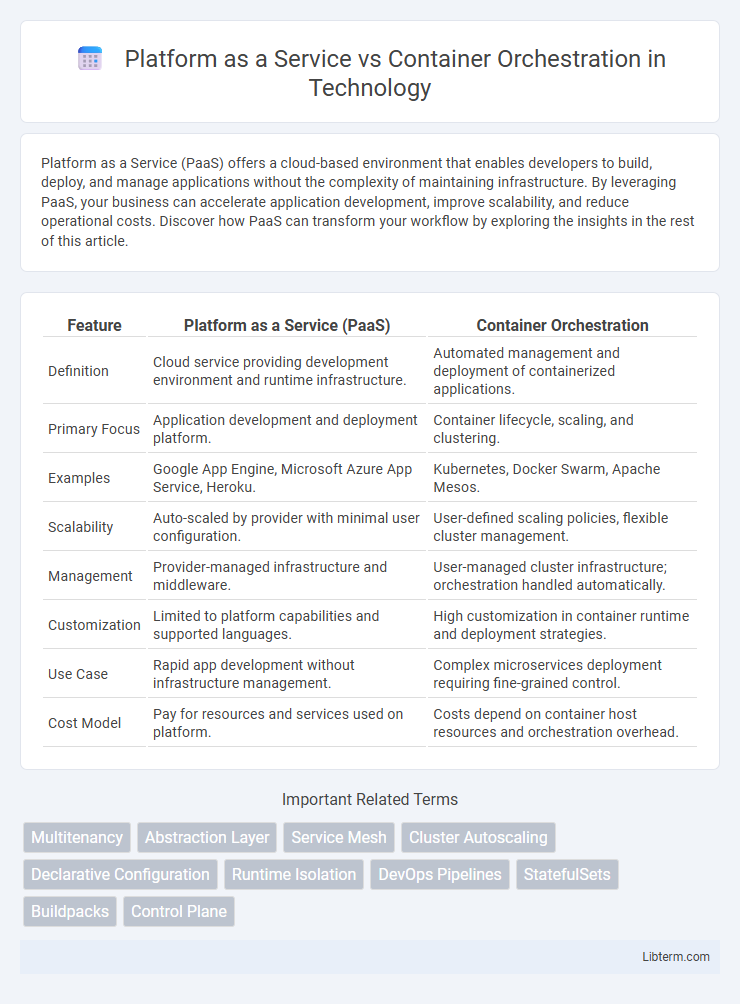Platform as a Service (PaaS) offers a cloud-based environment that enables developers to build, deploy, and manage applications without the complexity of maintaining infrastructure. By leveraging PaaS, your business can accelerate application development, improve scalability, and reduce operational costs. Discover how PaaS can transform your workflow by exploring the insights in the rest of this article.
Table of Comparison
| Feature | Platform as a Service (PaaS) | Container Orchestration |
|---|---|---|
| Definition | Cloud service providing development environment and runtime infrastructure. | Automated management and deployment of containerized applications. |
| Primary Focus | Application development and deployment platform. | Container lifecycle, scaling, and clustering. |
| Examples | Google App Engine, Microsoft Azure App Service, Heroku. | Kubernetes, Docker Swarm, Apache Mesos. |
| Scalability | Auto-scaled by provider with minimal user configuration. | User-defined scaling policies, flexible cluster management. |
| Management | Provider-managed infrastructure and middleware. | User-managed cluster infrastructure; orchestration handled automatically. |
| Customization | Limited to platform capabilities and supported languages. | High customization in container runtime and deployment strategies. |
| Use Case | Rapid app development without infrastructure management. | Complex microservices deployment requiring fine-grained control. |
| Cost Model | Pay for resources and services used on platform. | Costs depend on container host resources and orchestration overhead. |
Introduction to PaaS and Container Orchestration
Platform as a Service (PaaS) delivers a cloud-based environment that enables developers to build, deploy, and manage applications without handling underlying infrastructure. Container orchestration automates the deployment, scaling, and management of containerized applications, using tools like Kubernetes and Docker Swarm. Both technologies optimize application lifecycle processes, with PaaS abstracting infrastructure complexity and container orchestration enhancing operational efficiency for microservices and distributed systems.
Core Concepts: PaaS vs Container Orchestration
Platform as a Service (PaaS) provides a complete development and deployment environment in the cloud, abstracting infrastructure management to enable developers to focus on application code and business logic. Container orchestration automates the deployment, scaling, and management of containerized applications, using tools like Kubernetes or Docker Swarm to manage clusters of containers efficiently. PaaS emphasizes ease of use and integrated services, while container orchestration prioritizes flexibility and control over container lifecycle and resource allocation.
Architecture and Deployment Models
Platform as a Service (PaaS) architecture abstracts the underlying infrastructure, providing developers with pre-configured environments to deploy applications quickly, whereas container orchestration focuses on managing containerized applications using systems like Kubernetes to automate deployment, scaling, and management. PaaS deployment models typically run on cloud provider-managed environments with integrated middleware, while container orchestration supports hybrid and multi-cloud setups, enabling portability and consistency across diverse infrastructure. The architectural difference emphasizes PaaS's developer-centric abstraction versus container orchestration's infrastructure-level control for scalable microservices architectures.
Scalability and Flexibility Comparison
Platform as a Service (PaaS) offers scalability through managed environments that automatically adjust resources based on application demand, ideal for developers seeking simplified deployment without infrastructure management. Container orchestration, using tools like Kubernetes, provides granular scalability and flexibility by enabling dynamic container deployment, load balancing, and resource allocation across clusters, supporting complex microservices architectures. Compared to PaaS, container orchestration delivers higher customization and control over scaling policies, making it suitable for applications requiring adaptable infrastructure and multi-cloud portability.
Developer Experience and Productivity
Platform as a Service (PaaS) simplifies developer workflows by providing fully managed environments, enabling rapid application deployment without infrastructure management. Container orchestration, through tools like Kubernetes, offers granular control over containerized applications, improving scalability but requiring more expertise and setup time. PaaS enhances productivity by abstracting complexities, while container orchestration empowers developers with flexibility at the cost of a steeper learning curve.
Application Lifecycle Management
Platform as a Service (PaaS) streamlines application lifecycle management by providing integrated development, deployment, and monitoring tools, enabling faster iteration and reduced overhead. Container orchestration platforms like Kubernetes offer granular control over deployment, scaling, and management of containerized applications, enhancing consistency and resilience throughout the lifecycle. PaaS abstracts infrastructure complexity for developers, whereas container orchestration requires deeper operational involvement to manage infrastructure and application updates efficiently.
Security Considerations
Platform as a Service (PaaS) provides built-in security features like automatic patching, identity management, and compliance certifications, simplifying protection against common threats. Container orchestration platforms, such as Kubernetes, require diligent configuration of network policies, role-based access control (RBAC), and secret management to ensure secure multi-tenant environments. Both approaches necessitate continuous security monitoring and vulnerability scanning to prevent exposure of sensitive data and maintain robust defense against evolving cyberattacks.
Cost Structure and Resource Utilization
Platform as a Service (PaaS) typically employs a subscription-based cost structure with fixed pricing tiers, optimizing expenses through bundled services and automated management, which reduces overhead for development teams. Container orchestration platforms like Kubernetes use pay-as-you-go billing based on underlying infrastructure usage, enabling granular control over resource allocation and scaling, enhancing operational efficiency. PaaS abstracts infrastructure management to improve developer productivity but may result in less precise resource utilization, whereas container orchestration allows tailored resource provisioning, optimizing cost-effectiveness for complex, scalable applications.
Popular Platforms and Tools
Popular Platform as a Service (PaaS) solutions include Google App Engine, Microsoft Azure App Service, and Heroku, offering streamlined deployment and management for applications. In container orchestration, Kubernetes dominates as the leading open-source platform, alongside Docker Swarm and Apache Mesos, providing automated container deployment, scaling, and management. Both PaaS and container orchestration tools integrate with cloud providers like AWS, allowing developers to choose based on application complexity and control requirements.
Choosing the Right Solution for Your Needs
Choosing between Platform as a Service (PaaS) and container orchestration depends on your application scalability, management complexity, and customization requirements. PaaS offers a fully managed environment ideal for rapid development and deployment with minimal infrastructure management, while container orchestration platforms like Kubernetes provide granular control, scalability, and flexibility for large-scale, microservices-based architectures. Evaluating factors such as development speed, operational overhead, and workload portability ensures alignment with your business goals and technical capabilities.
Platform as a Service Infographic

 libterm.com
libterm.com